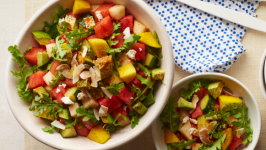Choosing The Right Summer Melon
Cut into a big slice of cold juicy watermelon and dig in! It's a sure sign that summer is in full swing when melons appear at your farmers' market. Cantaloupe, honeydew, casaba, canary, Crenshaw, and watermelon are the most well-known varieties. The melon varieties are endless and shopping the farmers’ market ensures that you’re getting the widest variety available and the freshest you can find. Each one has a distinctive sweet flavor and each is a must-try this season. Just chill and enjoy!
Selecting: Ripe muskmelons have a strong, sweet fragrance and give slightly when pressed at both ends. A fully ripe melon may have tiny cracks at the stem end. Choose melons that are heavy for their size and free of deep blemishes, shriveled peel or soft, moldy areas.
Storing: Store ripe melons in the refrigerator for up to 5 days. Although it will not obtain the flavor of a vine-ripened one, an unripe melon will sweeten slightly if left in a paper bag at room temperature for a few days. An exception is a honeydew melon, which will stay only as sweet as it was when harvested.
Preparing: Cut muskmelons in half and scoop out their seeds with a large spoon. To keep the melon moist, peel and cut off slices only as they are needed. Melons taste sweeter if served at room temperature or only slightly chilled. Remove them from the refrigerator about 30 minutes before serving.
Melons are in the same gourd family as squashes and cucumbers. Most melons have a similar structure to winter squash with thick flesh and an inner seed-filled mid-section. So what’s the difference between melons and squashes? It’s the way they’re used. Squashes are considered vegetables, while melons are known as fruits with sweet and juicy flavor.
The term melon describes a large round or oval fruit with skin that ranges from thin to very thick and encloses juicy flesh surrounding a central core of small seeds. Before they are even cut into, most melons have an alluring aroma that hints of the sweet, smooth flesh inside. The many melon varieties fall into two groups: muskmelons and watermelons. Muskmelons include netted melons like cantaloupe, with fine, raised ridges; they are generally at their peak from midsummer to early fall. The category of muskmelons known as winter melons includes smooth-skinned varieties like honeydew, which are at their best during the cooler autumn months. Here are some interesting varieties to watch for and try:
Crenshaw: Salmon-pink flesh yields a sweet, rich taste and slightly spicy aroma. These melons are large, weighing up to 10 pounds. Peak season: August through September.
Galia: The light-green flesh inside this melon is sweeter than that of the American cantaloupe; it's often reserved for dessert. Peak season: May through August.
Passport: A Passport melon is a green-fleshed "honeydew-type' melon with a rind that turns light green or pale yellow when ripe. The thick, sweet flesh is light green-almost white towards the seed cavity. It has a smooth flavor and fresh aroma.
Sprite: This grapefruit-sized melon has sweet, crisp ivory flesh, the taste of which contains hints of watermelon, honeydew, and pear—but much sweeter. Peak season: June and July.
Orange-Fleshed Honeydew: A luscious cross between cantaloupe and honeydew, with a slightly creamy flavor. Look for a smooth, whitish rind with a waxy texture. Peak season: May through August.





